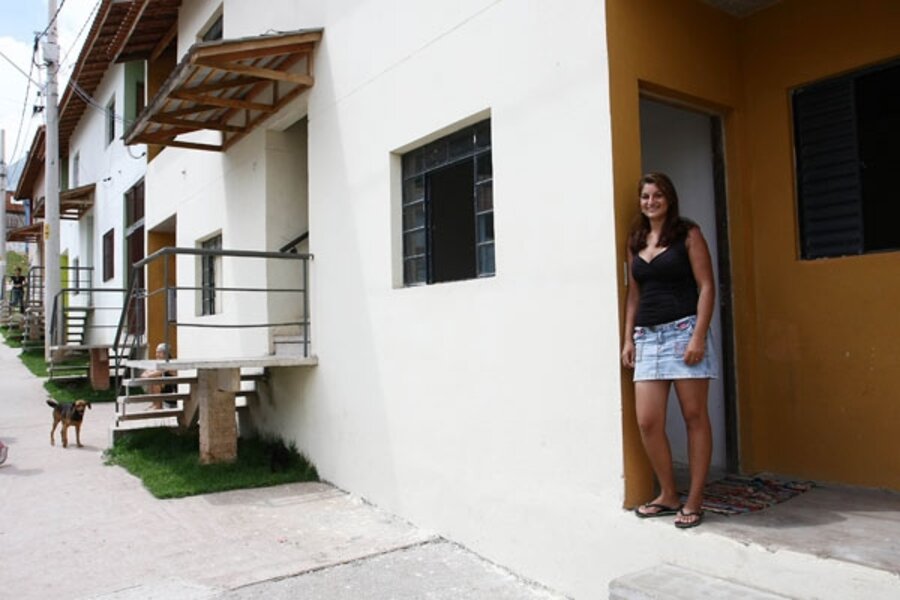Brazil stimulus does double duty
Loading...
| Osasco, Brazil
Just two years ago, Area Y was an ugly, stinking, rat-infested example of urban neglect.
Area Y was a favela, a Brazilian slum built atop a ravine and crowded with homes thrown together from wood, cement blocks, and corrugated iron. Some shacks stood on stilts to avoid the open sewer and floodwaters that ran below.
Today, the sewer is gone. The ravine has been filled in, and the wooden shacks have been replaced by two- and three-bedroom condominiums, some sporting solar panels. The same residents now live in the neighborhood, renamed Vila Vitoria.
“You see people on television saying their dream is to one day own a house. Well, I’ve got a house now,” says Mariangela Gomes, who lives here with her husband and 10-year-old daughter. “This is my dream come true.”
More than 1 million such “dreams” are to be built in Brazil, thanks to an ambitious government plan to reduce the shortage of low-income housing.
President Luiz Inácio Lula da Silva made infrastructure the centerpiece of a second term that began in 2007, vowing to spend $235 billion on hundreds of projects ranging from roads and bridges to airports and sewage-treatment plants.
Last month, he added to that with a two-year, $15 billion package to finance 1 million low-income homes as a way to not only combat the credit crunch, but also stimulate the economy and reduce the housing deficit.
“This is almost an emergency program,” President Lula said on March 25, “that on one hand is a response to the world economic crisis and resolves part of the housing problems that some Brazilians have, and at the same time allows us to create more jobs so we can create more wealth and get money circulating better in the Brazilian economy.”
The program includes financing for 400,000 homes for the very poor, who will be expected to pay back at least some of the loan with 10 percent of their earnings over 10 years. The rest will be for the slightly better off and the lower middle class.
Officials here in Osasco, a hardscrabble city of 800,000 on the outskirts of São Paulo, were delighted by the announcement. Like many of the 38 cities that ring South America’s largest metropolis, Osasco has a chronic lack of adequate housing.
The city has 170 favelas, home to an estimated 200,000. It had already set aside $20 million for new housing. The additional $55 million from the government is vital because it guarantees continuity, says the Brazil housing secretary, Sergio Gonçalves.
“We made this decision to undertake a major housing project, and we wanted to do it in the biggest favelas first,” Mr. Gonçalves said during a recent visit to Vila Vitoria. “This is for the poorest families, and that is what we really need to do.”
Here in Vila Vitoria, authorities removed the families from Area Y, filled in the ravine, and then built 748 new houses on top. The houses are small but infinitely better than the shacks they replaced. They are painted in cheerful pastel shades and set along wide streets with parking and green areas at one end. Some residents have put flowers in their windows and on stoops. Others have tiled the sidewalk outside their doors.
But there are also signs that, like many quickly built housing complexes across Brazil, the area could turn into the slum they were built to replace. Construction quality is low. And some residents are already operating small businesses from their homes, turning front rooms into hair and nail salons.
Osasco officials acknowledge the potential problems and say that social workers are helping the new residents adapt. Many people have never lived in a “proper” house before and need to learn transition skills. “We teach them how to live in a condominium situation,” says Sandra Moraes, director of Osasco’s Social Work Department. “They don’t know what goes and what doesn’t go in a common space.”
Brazil needs more Vila Vitorias. It has a housing deficit of at least 7 million, and those most in need are low-income families.
Urban planners say that while such projects are a marked improvement over favelas, proper oversight is vital in order to avoid the mistakes of the 1960s and ’70s, when quickly and poorly built developments turned into favelas.
These planners say that authorities need to ensure that areas chosen for development have infrastructure and transportation links. Construction companies must use quality materials to prevent houses from falling apart. And residents need to pressure officials to ensure standards are met.
“It is a good start,” says Maria Lúcia Martins, a lecturer in urban planning at one of São Paulo’s best-known universities. “But all those involved in the process, whether it is the states or the municipalities or the construction companies, must assume their responsibilities and do their work seriously. That is the challenge.”





